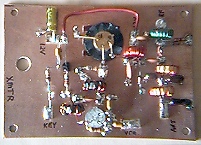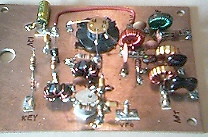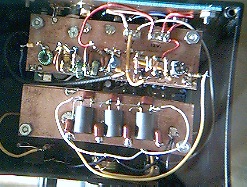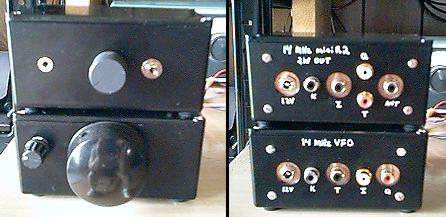AA3SJ
miniR2
20 Meter Transceiver Built Around the miniR2 Single-Signal Direct Conversion Receiver
Introduction
I'm a fan of the single-signal direct conversion receivers designed by Rick Campbell, KK7B. There is just something about the fidelity of a DC receiver that works with my ears and KK7B's circuits optimize that audio quality as well as provide single-signal performance that rivals many superhets. Presently, there are two kits available from Kanga U.S., the miniR2 and the R2Pro. I have the R2Pro kit on my bench but haven't built it yet. However, I have two transceivers built around the miniR2. One is set up for 30 meters and the one shown on this page is designed for 20 meters. The 30m rig is in one enclosure while my 20 meter version is housed in two small diecast aluminum enclosures: one for the VFO and the other for the transmitter, receiver, and sidetone circuitry.
Details
Below are several photos which show some of the detail of the 20m rig. The transmitter is built on a board identical in size to the miniR2. The filter board and RF preamp / sidetone oscillator boards are cut to match the hole spacing of the miniR2 as well. All three are stacked within the diecast enclosure. The transmitter is on the bottom; the receiver next, and the the filter and preamp boards on top.


Two photos of the transmitter board which is designed following KK7B's article, A Small High-Performance CW Transceiver, in QRP Power, p. 3-33ff. My transmitter uses a different driver (2n3866) and a different final (MRF 341), producing a little over 2 watts output.

Here is a photo of the RF preamp / sidetone oscillator boards (top) and the 1kHz CW passive audio filter board (bottom). A DPDT switch toggles the 3kHz wide filter which is on the receiver board itself and the 1kHz narrow filter. The receiver itself is slightly visible beneath these boards.
 Finally, here is a photo of both the VFO unit (bottom) and the Transceiver (top). The entire package is quite small and, I think, neat. As you can see, one disadvantage of having a separate VFO is that quite a few jumper cables are needed: VFO I and Q for the receiver, VFO T for the transmitter, and a combined Key line. I used RG174 and RCA plugs/jacks for all but the power connections.
Finally, here is a photo of both the VFO unit (bottom) and the Transceiver (top). The entire package is quite small and, I think, neat. As you can see, one disadvantage of having a separate VFO is that quite a few jumper cables are needed: VFO I and Q for the receiver, VFO T for the transmitter, and a combined Key line. I used RG174 and RCA plugs/jacks for all but the power connections.
Performance
The miniR2 performs quite well even in the presence of very strong signals. If the signal is S9 or less I cannot hear anything of the opposite side of the signal. However, S9 or better signals produce a very weak, but hardly noticeable, signal on the opposite side. In my neck of the woods, Pennsylvania, I can hear some short wave broadcast interference from Radio Canada International. If I use my SPC tuner, rather than a T-circuit tuner, the broadcast signals are reduced to barely perceivable background noise. I may build a bandpass filter for the receiver, but haven't yet decided if I have room inside the enclosure.
Having listened to a high-performance DC receiver like the miniR2, you will tend to compare all your other receivers against that standard. It works that well!






